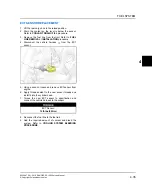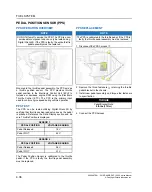
4.22
9928487 R01 - 2018 RANGER XP 1000 Service Manual
© Copyright Polaris Industries Inc.
FUEL PUMP TEST
If a fuel delivery problem is suspected, make certain the
fuel pump filter is not plugged, that the pump is being
activated through the ECU, all electrical connections are
properly secured, the fuses are good, and a minimum of
7.0 volts is being supplied. If during starting the battery
voltage drops below 7.0 volts, the ECU will fail to operate
the system.
WARNING
Fuel is extremely flammable and may cause severe
burns, injury, or death.
Do not use any device that produces a flame or
electrical devices that may spark around
fuel or fuel vapors.
1. Couple Fuel Pressure Gauge Adapter
(PS-48762)
to
the Fuel Pressure Gauge Kit
(PU-43506-A)
.
2. Lift the rear cargo box to the raised position.
3. Install the Fuel Pressure Gauge Adapter
(PS-48762)
in-line between the fuel pump outlet and the fuel line.
4. Turn on key switch to activate the pump and check
the system pressure on the gauge. If fuel pressure is
within specification, the ignition switch, ECU, fuel
pump and pressure regulator are working properly.
Turn the key switch off and turn the relief valve on the
tester to relieve the system pressure.
Fuel Pressure:
58 ± 2 psi (400 ± 14 kPa)
NOTE
If the fuel pressure is out of specification, replace the
fuel pump assembly.
5. If the pump did not activate, disconnect the harness
connector from the fuel pump. Connect a DC
voltmeter across terminals “3” and “4” in the plug on
the vehicle fuel pump harness. Turn on the key switch
and observe voltage to ensure a minimum of 7 volts is
present.
NOTE
If the voltage was below 7 VDC, test the battery, ignition
switch, relay(s), wiring harness and ECU.
6. If the reading is between 7 and 14 volts, turn key
switch off and connect an ohmmeter between
terminals “3” and “4”' at the white fuel pump
connector to check for continuity within the fuel pump.
NOTE
If there was no continuity between the pump terminals,
replace the fuel pump assembly.






























